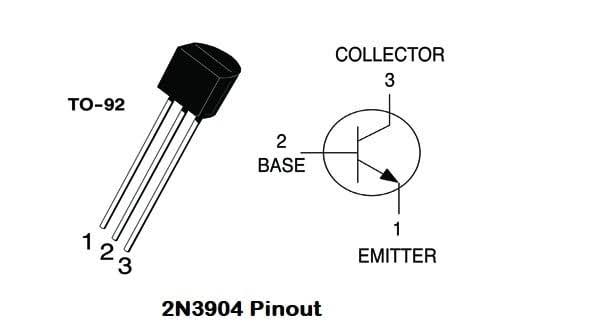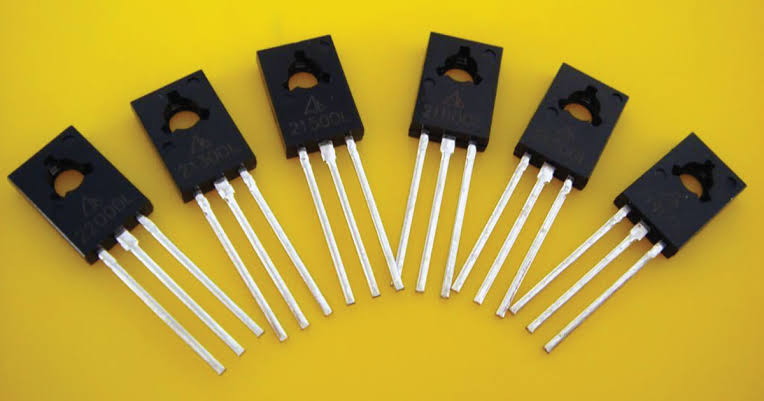What is 2N3904 Transistor and How it works?
2N3904 Transistor – You’ll find multiple power transistors in electronic components, each suited to a different function. In this article we are discussing the 2N3904. Mainly, we will dwell on its essential details, such as its pinout, features, and uses. First we will discuss basics like what is a Transistor, NPN Transistor and how it works?
What is a transistor ?
A transistor, also known as a BJT (Bipolar Junction Transistor), is a current-driven semiconductor device that can be used to control the flow of electrical current in which a small amount of current in the base conductor controls a larger amount of current.
The transistor is a semiconductor device with three terminals called base, emitter and collector. It is used to function in electronic circuits such as rectifiers, amplifiers, switches… These symbols can be represented within a circle.
There are many uses for transistors and some are top secret.
- Amplification. Amplifiers use transistors to amplify sound.
- Switches. Many switches use transistors to turn on and off.
- Computers.
- Hearing aid.
- spokes.
- Space exploration.
Where are transistors used besides switches and amplifiers?
BJT transistors have many applications in the field of electronics, but are commonly used as electronic switches, signal amplifiers, or low-power switches.
What is the function of an NPN transistor?
An NPN transistor, which is also called a BJT, can be used for two things. The transistor can function as an electronically controlled switch or as an amplifier with variable gain. The transistor is also the basis for the development of digital systems such as logic gates.
How is an NPN transistor connected?
A transistor of type npn and β= 100 is connected as follows: the base is connected to the positive terminal of a 5 V battery through a 100 ohm resistor; the collector is connected to the positive terminal of another 10V cell through a 100 ohm resistor the emitter is connected to the terminals…
How is an NPN transistor powered?
An NPN transistor is powered when a sufficient current is supplied to the base of the transistor. Therefore, the base of an NPN transistor must be connected to a positive voltage for current to flow in the base. A PNP transistor is the opposite.
What is 2N3904 Transistor and How it works?
A 2N3904 transistor is a negative-positive bipolar (NPN) transistor, which means that it is generally applicable to negative ground circuits. It can be used for audio signals as well as medium speed switching applications. This little transistor is the counterpart of the 2N3906 transistor, which is a positive-negative-positive (PNP) transistor. By injecting a small base current into a 2N3904 transistor, a larger collector current can be produced.

This transistor has three terminals called the emitter, the base, and the collector. The emitter and collector are the main terminals of the 2N3904 transistor. Depending on the circuit configuration, the load or equivalent load can be connected to either the emitter or the collector. For a current gain of 100, a change of 0.001 amps (A) in the base current results in a 0.1 A change in the collector. This suggests how the 2N3904 transistor can be turned into an amplifier. A small change in base current leads to a hundred times the change in collector current, which can translate into a change in voltage or current. By designing cascaded transistor stages, it is possible to build amplifiers, switches, and oscillators for various applications. Shunt refers to the quiescent currents at the transistor terminals. As a general rule, the 2N3904 transistor requires a forward biassed base to emitter, which means that there is a positive potential at the base, with reference to the emitter.
It should be noted that the base is a positive (P) type material, while the emitter is a negative (N) type material. The amount of forward bias has to be controlled depending on the specific application. Excessive forward bias often causes excessive collector current, which usually leads to saturation. When there is a reverse bias of the base-emitter junction, the collector current is generally close to zero. This leads to a cutoff point, or the condition that occurs when the collector current is almost zero. In switching and radio frequency applications, near-cutoff operations are used to turn off the load current in the collector.
For RF applications, operating near cutoff makes it possible to “pulse” a special circuit known as a tank circuit, which resonates like the way a pendulum bob changes when nudged.
The use of transistor 2n3904
2N3904 as switch
Operating this Transistor to switch involves using it in the saturation and cutoff regions. Thus the Transistor will act as an open switch during forward bias mode. Rather, it will function as a closed switch when you put it in reverse bias mode.
You can control the bias mode by supplying the appropriate current to the base pin. In this case, the maximum bias current should not exceed 5mA. Otherwise it will destroy the transistor.
Therefore, connecting a resistor in series with the base pin is a must to prevent this.
2N3904 as amplifier
For a transistor to function as an amplifier, it must operate in the active region. In this mode, its power, voltage, and current amplification are adequate in three main settings. Among them are:
common collector amplifier
2n3904-The common emitter amplifier
common base amplifier
The most common configuration you will find in amplification circuits is the common emitter. Also, you can calculate the DC gain of the transistor as an amplifier using the formula
DC current gain = the collector current / base current.



